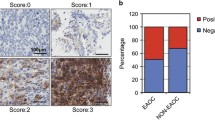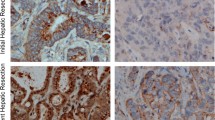Abstract
Abnormal c-Src expression and activation has been observed in a number of tumors. To determine the therapeutic potential of Src inhibitors for ovarian cancer patients, this study aimed to explore the expression patterns of c-Src and phospho-Src in epithelial ovarian cancer. A total of 82 patients with epithelial ovarian cancer treated at Sun Yat-sen University Cancer Center from January 1999 to December 2005 were enrolled along with 25 patients with benign ovarian lesions; 20 normal ovarian tissues served as controls. Expression of c-Src and phospho-Src (Tyr416) was examined using immunohistochemistry. Survival analyses were performed using Kaplan–Meier curves. As compared to the control group, a significantly greater proportion of ovarian cancer tissues were positive for c-Src and phospho-Src expression (P < 0.001). c-Src expression was associated with age, while phospho-Src expression was significantly associated with age, FIGO stage, histology grade, and residual tumor size after surgery (all P < 0.05). The mean survival time was associated with phospho-Src expression, but not with c-Src expression. The mean survival times of patients with phospho-Src-positive tumors were significantly greater than those with phospho-Src-negative tumors (87.4 months, 95 % CI = 74.3–100.5 months and 91.5 months, 95 % CI = 84.7–98.2 months, respectively; P = 0.013). The increased c-Src expression and activation in epithelial ovarian cancer suggests that ovarian cancer patients may benefit from tyrosine kinase inhibitors such as Dasatinib. Activation of c-Src through phosphorylation at Tyr416 may play a role in the early stages of ovarian cancer development, and evaluation of its expression may be a useful prognostic marker of epithelial ovarian cancer.


Similar content being viewed by others
Abbreviations
- VEGF:
-
Vascular endothelial growth factor
- DAB:
-
Diaminobenzidine tetrahydrochloride
- FIGO:
-
The International Federation of Gynecology and Obstetrics
References
Rubin SC, Randall TC, Armstrong KA et al (1999) Ten-year followup of ovarian cancer patients after second-look laparotomy with negative findings. Obstet Gynecol 93:21–24
Kim A, Ueda Y, Naka T, Enomoto T (2012) Therapeutic strategies in epithelial ovarian cancer. J Exp Clin Cancer Res 31:14–22
Jinawath N, Vasoontara C, Jinawath A et al (2010) Oncoproteomic analysis reveals co-upregulation of RELA and STAT5 in carboplatin resistant ovarian carcinoma. PLoS ONE 5:e11198
Secord AA, Teoh DK, Barry WT et al (2012) A phase I trial of Dasatinib, an SRC-family kinase inhibitor, in combination with Paclitaxel and Carboplatin in patients with advanced or recurrent ovarian cancer. Clin Cancer Res 18:5489–5498
Schilder RJ, Brady WE, Lankes HA et al (2012) Phase II evaluation of Dasatinib in the treatment of recurrent or persistent epithelial ovarian or primary peritoneal carcinoma: a Gynecologic Oncology Group study. Gynecol Oncol 127:70–74
Egan C, Pang A, Durda D et al (1999) Activation of Src in human breast tumor cell lines: elevated levels of phosphotyrosine phosphatase activity that preferentially recognizes the Src carboxy terminal negative regulatory tyrosine 530. Oncogene 18:1227–1237
Mazurenko NN, Kogan EA, Zborovskaya IB et al (1992) Expression of pp 60c-src in human small cell and non-small cell lung carcinomas. Eur J Cancer 28:372–377
Lutz MP, Esser IB, Flossmann-Kast BB et al (1998) Overexpression and activation of the tyrosine kinase Src in human pancreatic carcinoma. Biochem Biophys Res Commun 243:503–508
Brown MT, Cooper JA (1996) Regulation, substrates and functions of src. Biochim Biophys Acta 1287:121–149
Xu W, Allbritton N, Lawrence DS (2012) SRC kinase regulation in progressively invasive cancer. PLoS ONE 7:e48867
Heintz APM, Odicino F, Maisonneuve P et al (2006) Carcinoma of the ovary. Int J Gynecol Obstet 95:S161–S192
Verbeek BS, Vroom TM, Adriaansen-Slot SS et al (1996) c-Src protein expression is increased in human breast cancer. An immunohistochemical and biochemical analysis. J Pathol 180:383–388
Kumble S, Omary MB, Cartwright CA, Triadafilopoulos G (1997) Src activation in malignant and premalignant epithelia of Barrett’s esophagus. Gastroenterology 112:348–356
Irby RB, Yeatman TJ (2000) Role of Src expression and activation in human cancer. Oncogene 19:5636–5642
Frame MC, Fincham VJ, Carragher NO et al (2002) v-Src’s hold overactin and cell adhesions. Nature Rev Mol Cell Biol 3:233–245
Talamonti MS, Roh MS, Curley SA et al (1993) Increase in activity and level of pp 60c-src in progressive stages of human colorectal cancer. J Clin Investig 91:53–60
Peng Z, Raufman JP, Xie G (2012) Src-mediated cross-talk between farnesoid x and epidermal growth factor receptors inhibits human intestinal cell proliferation and tumorigenesis. PLoS ONE 7:e48461
Han LY, Landen CN, Travino JG et al (2006) Antiangiogenic and antitumor effects of SRC inhibition in ovarian carcinoma. Cancer Res 66:8633
Kim HS, Han HD, Armaiz-Pena GN et al (2011) Functional roles of Src and Fgr in ovarian carcinoma. Clin Cancer Res 17:1713–1721
Le XF, Bast RC Jr (2011) Src family kinases and paclitaxel sensitivity. Cancer Biol Ther 12:260–269
Kong L, Deng Z, Zhao Y et al (2011) Down-regulation of phospho-non-receptor Src tyrosine kinases contributes to growth inhibition of cervical cancer cells. Med Oncol 28:1495–1506
Pengetnze Y, Steed M, Roby KF et al (2003) Src tyrosine kinase promotes survival and resistance to chemotherapeutics in a mouse ovarian cancer cell line. Biochem Biophys Res Commun 309:377–383
Wiener JR, Windham C, Veronica C et al (2003) Activated src protein tyrosine kinase is overexpressed in late-stage human ovarian cancers. Gynecol Oncol 88:73–79
Weber TK, Steele G, Summerhayes IC (1992) Differential pp 60c-src activity in well and poorly differentiated human colon carcinomas and cell lines. J Clin Investig 90:815–821
Desouki MM, Rowan BG (2004) Src kinase and mitogen-activated protein kinases in the progression from normal to malignant endometrium. Clin Cancer Res 10:546–555
Ben-Izhak O, Cohen-Kaplan V, Nagler RM (2010) The prognostic role of phospho-Src family kinase analysis in tongue cancer. J Cancer Res Clin Oncol 136:27–34
Acknowledgments
This study was funded by research grants from the Technology Project of Guangdong Province (No. 2009B030801021). The study sponsors had no role in the study.
Conflicts of interest
None.
Author information
Authors and Affiliations
Corresponding author
Additional information
Article note
Yong-Wen Huang and Chen Chen contributed equally to this work as co-first authors
Electronic supplementary material
Below is the link to the electronic supplementary material.
Rights and permissions
About this article
Cite this article
Huang, YW., Chen, C., Xu, MM. et al. Expression of c-Src and phospho-Src in epithelial ovarian carcinoma. Mol Cell Biochem 376, 73–79 (2013). https://doi.org/10.1007/s11010-012-1550-1
Received:
Accepted:
Published:
Issue Date:
DOI: https://doi.org/10.1007/s11010-012-1550-1




